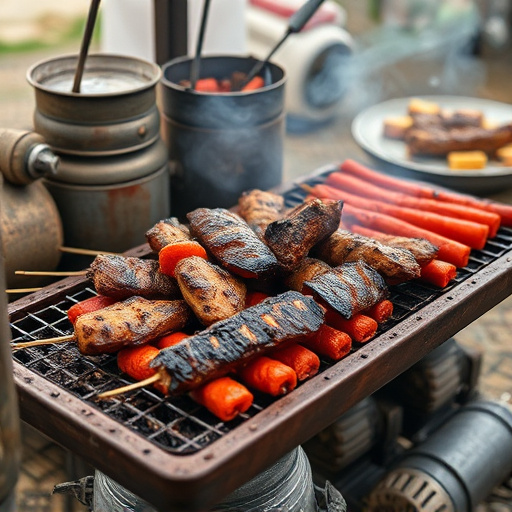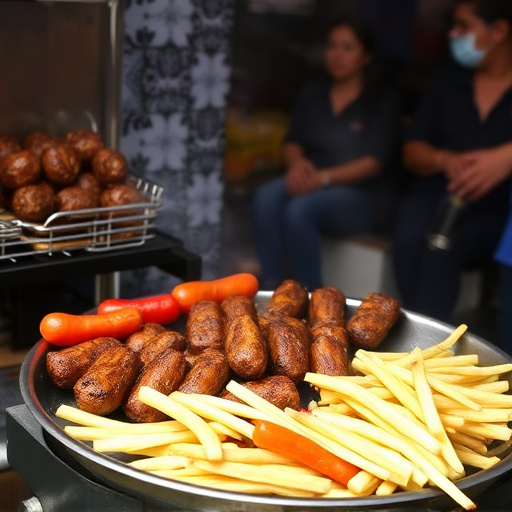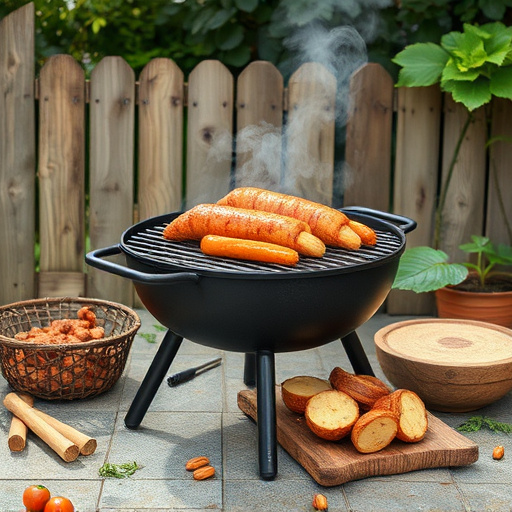Smoked BBQ Brisket is a beloved dish, celebrated for its rich flavors and contrasting textures. This guide delves into crafting the perfect recipe through low-and-slow cooking techniques. Key steps include choosing the right smoker and fuel (like wood chips or chunks), creating a balanced dry rub and sauce blend, maintaining a consistent 225°F – 250°F temperature range, and using butcher paper for moisture retention. The result is tender, juicy brisket that showcases the art of BBQ mastery.
“Unleash your inner BBQ master with the ultimate guide to crafting the perfect smoked BBQ brisket recipe. From understanding the cut’s unique characteristics to mastering low and slow cooking techniques, this journey promises tender, juicy results. Learn to choose the ideal smoker and fuel, blend mouthwatering dry rubs and sauces, and discover smoking tips that will transform your brisket into a culinary masterpiece. Get ready to impress with this authentic, smoky delight.”
- Understanding Brisket: The Cut and Its Characteristics
- The Art of Low and Slow Cooking for Maximum Flavor
- Choosing the Right Smoker and Fuel for Your BBQ Brisket
- Dry Rub and Sauce: Crafting the Perfect Seasoning Blend
- Smoking Techniques and Tips to Achieve Tender, Juicy Results
Understanding Brisket: The Cut and Its Characteristics

Brisket, a cut of meat from the breast of a cow, is a favorite among smoked BBQ enthusiasts for its incredible flavor and tender texture when cooked low and slow. This specific cut is known for its thick layer of fat, which not only keeps the meat moist during the cooking process but also adds rich, smoky flavors when rendered during smoking. Understanding the characteristics of brisket is key to crafting the perfect smoked BBQ brisket recipe.
The brisket has two main muscles: the lean “first cut” or “flat,” and the fattier “second cut” or “point.” When cooking brisket for a smoked BBQ dish, both parts contribute uniquely to the final product. The fat helps insulate the meat during low-temperature cooking, ensuring it stays tender and juicy. Moreover, the contrasting textures of the lean and fatty sections create a delightful dining experience, with each bite offering a balance of flavor and tenderness.
The Art of Low and Slow Cooking for Maximum Flavor

The art of low and slow cooking is a technique that transforms ordinary cuts of meat into mouthwatering culinary delights, particularly when applied to a smoked BBQ brisket recipe. This method involves cooking meat at low temperatures for an extended period, allowing it to break down and become incredibly tender while infusing every bite with rich, complex flavors. The result is a melt-in-your-mouth experience that has made smoked BBQ brisket a favorite among meat enthusiasts worldwide.
This slow and steady approach ensures the brisket retains its natural juices, creating a juicy, succulent texture. The low heat promotes the Maillard reaction, contributing to the development of a stunning crust while enhancing the overall flavor profile. For aspiring chefs looking to master this technique, it’s about understanding the science behind the process and the patience required to let the flavors gently meld together, creating a dish that truly celebrates the art of BBQ.
Choosing the Right Smoker and Fuel for Your BBQ Brisket

When it comes to crafting the perfect smoked BBQ brisket recipe, selecting the right smoker and fuel is half the battle won. There are various types of smokers available in the market, each with its unique features and cooking styles. For a consistent and flavorful result, opt for a reliable smoker that allows precise temperature control and even heat distribution. A digital controller can help you monitor and adjust settings easily, ensuring your brisket cooks low and slow as required.
Choosing the right fuel is equally important. Wood chips or chunks are popular choices for smoking, each offering distinct flavors. Apple, hickory, and mesquite are common options known for their sweet, smoky aromas. Experiment with different fuels to find the one that complements your brisket’s taste profile. Fuel choice can significantly impact the overall flavor, so select wisely based on your preferred smoked BBQ brisket recipe.
Dry Rub and Sauce: Crafting the Perfect Seasoning Blend

The key to a mouthwatering smoked BBQ brisket recipe lies in the perfect blend of dry rub and sauce. Crafting the ideal seasoning mix is an art, combining various spices to create a complex flavor profile that enhances the natural juices of the brisket. A well-crafted dry rub should include a balance of spices like salt, pepper, garlic powder, onion powder, paprika, and chili powder, each adding its unique taste and texture. This blend is then applied directly to the meat, creating a delicious crust as it smokes.
For a truly exceptional result, consider adding a touch of liquid smoke for an extra layer of depth. The rub should be generous but not excessive, allowing the brisket’s natural marbling to shine through. As the meat slowly cooks low and slow, the spices penetrate the flesh, resulting in tender, juicy slices that simply melt in your mouth. Pair this with a flavorful sauce made from a base of vinegar, tomato paste, brown sugar, and various herbs and spices, and you’ve got a smoked BBQ brisket recipe that’s sure to impress.
Smoking Techniques and Tips to Achieve Tender, Juicy Results

When it comes to achieving that perfect, tender, and juicy smoked BBQ brisket recipe, understanding the art of smoking is key. The low-and-slow method ensures a melt-in-your-mouth texture, and mastering this technique lies in controlling temperature and smoke exposure. Aim for a consistent heat range between 225°F to 250°F (107°C to 121°C) throughout the cooking process. This slow cooking allows the collagen in the brisket to break down, resulting in tender meat.
Tip-wise, using a combination of wood chips or chunks for smoking adds flavor without overpowering the natural beef taste. Oak, hickory, and mesquite are popular choices, each imparting unique smoky notes. Ensure even smoke distribution by maintaining a steady flame and regularly replenishing the fuel source. Additionally, wrapping the brisket in butcher paper partway through cooking can help retain moisture, ensuring juicy results.
